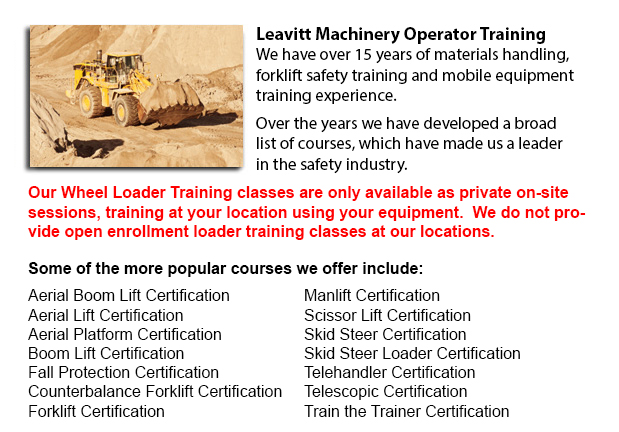
Wheel Loader Operator Training Saskatchewan - In order to pick up significant loads, industrial cranes utilize levers and pulleys. Before, Roman people used cranes in order to raise enormous monuments making the origin of these machines at least 2,000 years ago. Many Medieval churches utilized cranes in their creation as well as the Egyptians may have utilized them when constructing the pyramids.
New cranes can either be simple or complex, based upon the nature of the application they can perform. For example, mobile cranes are somewhat simple units. A steel truss and even a telescopic boom mounts its movable platform. A system of pulleys or levers lifts the boom and there is normally a hook hanging. These cranes are frequently designed for earthmoving or demolition by changing the hook out with one more piece of device like for instance a bucket or wrecking ball. Telescopic cranes have a series of hydraulic tubes which fit together to form the boom. These units could also be mobile.
Both traditional or specialized wheels could be used for railroad track or caterpillar track enabling these boom trucks to be able to move on upaved and uneven surfaces.
Truck mounted and rough terrain cranes are mobile also. Outriggers are situated on the truck mounted unit to improve stability, while rough terrain cranes comprise a base which tends to resemble the bottom of a 4-wheel drive. These cranes are equipped in order to function on rough ground making them best in the construction trade for instance.
Gantry cranes are utilized so as to transfer and unload big containers off of trains and ships. They are usually seen functioning in ports and railroads. Their bases have very big crossbeams that run on rails so as to pick up containers from a place to another. A portainer is a special type of gantry that transfers materials onto and off of ships specifically.
Floating cranes are connected on pontoons or barges and are one more important piece of equipment vital to the shipping industry. For the reason that they are located in water, they are utilized for a variety of services consisting of building bridges, salvaging ships and port construction. Floating cranes can handle very heavy loads and containers and like portainers, they can likewise unload ships.
Loader cranes are fit onto trailers with hydraulic powered booms to load goods onto a trailer. If not in use, the jointed sections of the boom could be folded down. This type of crane can be likewise considered telescopic since a section of the boom may telescope for more versatility.
Often utilized in automated warehouses, stacker cranes tend to follow an automated retrieval system and could function using a remote. These cranes are equipped together with a forklift machinery and can be seen in big automated freezers, stacking or obtaining foodstuff. Using this particular type of system allows employees to remain out of that freezing setting.
Tower cranes, often the tallest type, usually do not have a movable base. They need to be assembled part by part. Their base is like a long ladder along with the boom at a 90 degree angle to the base. These cranes specialize in the construction of tall structures and are usually connected to the inside of the building itself all through the construction period.
-
Forklift Ticket Saskatchewan
Forklift Ticket Saskatchewan - Pallet jacks and forklifts are both meant for basically the same purpose; to move supplies from one location of your warehouse to another. This is pretty much where the comparison stops however. With the pallet jack, th... More -
Loader Ticket Saskatchewan
Loader Ticket Saskatchewan - Gehl articulated loaders have been made to suit practically any condition. They provide great traction and optimal maneuverability due to a heavy-duty oscillating joint that offers forty five degree rotating angles left a... More -
Forklift Training Programs Saskatchewan
Forklift Training Programs Saskatchewan - Are you searching for work as a forklift driver? Our regulatory-compliant mobile equipment operator training provides instruction in kinds of forklifts, pre-shift check, fuel kinds and handling of fuels, and... More -
Heavy Equipment Operator Classes Saskatchewan
Heavy Equipment Operator Classes Saskatchewan - A heavy equipment operator is an individual who has received the right training in order to operate a particular kind or piece of machinery. There are lots of ways for the operator to undergo training a... More -
Telehandler Training in Saskatchewan
Telescopic handlers usually known as telehandlers for short, are an extremely popular piece of heavy construction equipment. They are usually utilized in the construction and agricultural trades. These equipments have farthest reaching capacity and a... More -
Narrow Aisle Forklift / Order Picker Training / Electric Pallet Jack / Electric Pallet Truck Training in Saskatchewan
A pallet lift is a piece of equipment dedicated in the transporting of pallets of various dimensions and weights. They can be utilized as an attachment for forklifts, cranes and other types of heavy machinery or be applied on their own. Pallet lifts... More -
Operator Safety Training, Re-Qualification Training, In-House Instructor Training in Saskatchewan
Used in just about all industrial construction sites, warehouse operations or boat yards, the lift truck is a very important component so as to help pick up and transfer supplies. The reach feature of a forklift can help improve the applications whic... More -
Aerial Lift Ticket Saskatchewan
Aerial Lift Ticket Saskatchewan - Boom vehicle are often used by phone, cable and utilities firms as they have extended folded arms which are generally folded over the roofs of business vehicles. On the end of the extension of extendable arms usually... More

Forklift Training Saskatchewan
TOLL FREE: 1-888-254-6157
Saskatoon, Saskatchewan
forklifttrainingsaskatchewan.com
Email Us
About Us



